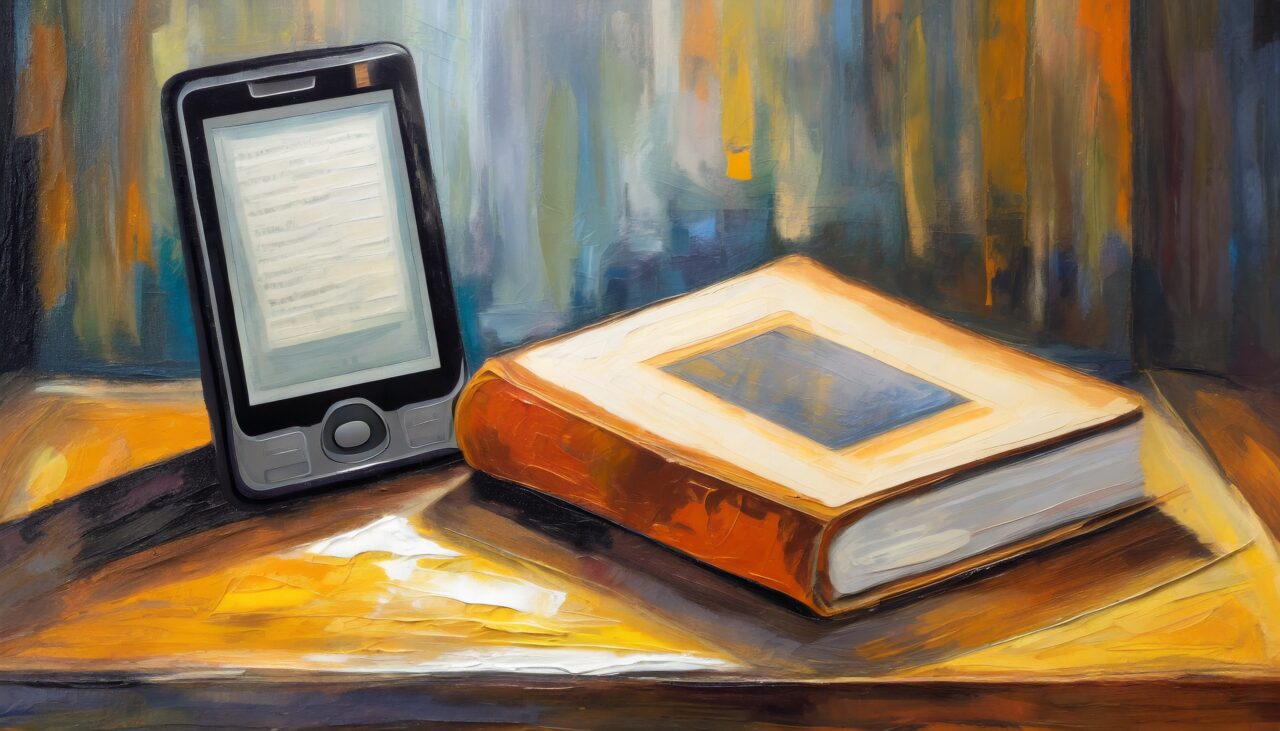
Welcome, book lovers and eco-conscious readers alike, to a topic that bridges the pages of tradition with the pixels of innovation. As we flip through the chapters of this debate, we uncover the nuances of sustainability, the convenience of technology, and the timeless charm of a printed page.
In our quest for knowledge, entertainment, and escape, digital or tangible books stand as our loyal companions. But today’s literary landscape poses a critical question: which format better upholds the values of our ever-evolving society?
Armed with facts and a touch of nostalgia, we’ll journey together through the environmental impacts of e-readers, compare them to the carbon footprint of print books, and delve into why, perhaps, the soft rustle of turning pages might harmonize more sweetly with Mother Nature's song.
This is not just about choosing sides; this is an exploration for truth-seekers and sentimental souls, for the tech-savvy and the environmentally-minded. Join us as we decipher why some readers are drawn to the sleek screens of e-books while others find sanctuary in the tactile embrace of print.
Our goal is to stoke the embers of your print book passion and advocate for the ultimate eco-friendly reading—cherishing and circulating used books. The tale of e-books vs. print books unfolds before us—not as adversaries but as narratives vying for a place in our hearts and shelves. Let's turn the page, shall we?

Sustainability Showdown
When it comes to the health of our planet, every choice we make, down to the format of the books we read, carries weight. Let’s dive into the sustainability aspect of this debate, where we find that the impact of our literary preferences runs deeper than ink or pixels.
The Carbon Footprint of E-Readers
The modern e-reader is a compact library that stores thousands of books in a single device. But behind this convenience lies an often-overlooked environmental cost. The production of e-readers involves mining for metals, manufacturing plastic components, and assembling electronic parts—a process that emits a significant amount of greenhouse gases. Research indicates that the carbon emissions released during the creation of a single e-reader are tantamount to the carbon footprint of several hundred print books.
E-readers also have a finite lifespan, compounded by the rapid pace of technological obsolescence and upgrades. Therefore, their environmental impact does not end after production; e-waste disposal becomes another challenge as these gadgets eventually end their useful life.
The Longevity of Print Books
In stark contrast, print books tell a tale of endurance. Once a book is printed, its ecological impact is largely fixed, with no further energy required for its use—no charging, software updates, or battery replacements. The physical book has impressive durability, often transcending time and generations.
Its continued existence doesn't depend on technology that can quickly become outdated. The legacy of a well-crafted print book is its potential to remain readable for centuries with minimal additional environmental cost.
The Second Life of Books
The sustainability narrative for print books gains even more momentum when considering the reuse and sharing culture. Used bookshops, library sales, and book exchanges breathe new life into pre-owned books, enhancing their environmental credentials. Purchasing a used book circumvents the need to use additional resources for new printing while keeping books out of landfills—though print books in landfills are much less toxic than e-readers due to their organic makeup.
The community shaped around second-hand books can be both vibrant and heartening. Readers share stories, recommendations, and books themselves, creating social value while promoting sustainability. Furthermore, the re-circulation of books supports local economies and reduces the carbon footprint associated with shipping new books across the globe.
In this sustainability showdown, print books—especially those that are lovingly used—present a compelling case for being the eco-friendlier contender. They carry the weight of history in their pages and their potential to be passed on, creating an ongoing, low-impact legacy in a world keen on upcycling and mindful resource use.

Ease-of-Use and Accessibility
While sustainability forms the bedrock of our reading choices, the practicalities of everyday use play a pivotal role for many readers. Here, we compare the accessibility and user experience of e-books and print books.
The Advantages of E-Books
For avid readers who crave convenience, e-books can appear to be the clear frontrunner. With a single device, you can carry an entire library, saving valuable space in bags and bookshelves. This particularly benefits those who travel often or live in smaller spaces.
The technology behind e-readers also affords features that enhance accessibility, appealing to various audiences. Text size can be adjusted for comfortable reading, which is a significant advantage for readers with visual impairments. Additionally, built-in dictionaries, search functions, and hyperlinks to external content enrich the learning experience.
Ease purchasing and downloading books instantly is another strong suit for e-books. They provide immediate access to the latest releases or time-honored classics without leaving the comfort of home. For those who prioritize immediate access and portability, e-books are a pragmatic solution.
The Tactile Experience of Print Books
Despite the digital convenience, print books hold their ground with a sensory appeal that e-books can't replicate. The feeling of flipping through pages, the smell of paper, and the sight of ink bound within a cover offer a multi-sensory experience that many readers find comforting and immersive.
Print books also afford a different ease of use: the ability to quickly flip back and forth between pages, scribble notes in the margins, and use physical bookmarks. The tangibility contributes to a deeper level of engagement that some readers argue enhances memory and retention. There is no battery to charge, no screen glare to contend with, and no interruptions from notifications—a print book offers a singular focus on the reading experience.
For children, the tactile qualities of print books can be especially important, helping to develop fine motor skills and an early love of reading. For all ages, the joy of sharing a beloved book with a friend or returning a much-appreciated text to a community library remains a meaningful and collective human experience.
In the battle for ease of use and accessibility, e-books shine with their modern features and portability, while print books boast a timeless and irreplaceable sensory allure. The victor in this realm comes down to personal preferences and the distinct circumstances of each reader's lifestyle. Whether it's the sleek efficiency of an e-reader or the classic charm of a paper book, the bottom line is that reading remains an essential, enriching activity—no matter the format.

Other Considerations
The debate between e-books and print books extends beyond environmental concerns and user experience. As we flip through other pages of this complex comparison, let’s delve into additional factors readers might weigh when choosing their preferred format.
The Cost Factor
At first glance, an e-reader appears to be a sizable investment compared to purchasing a paperback or hardcover book. However, this initial cost must be viewed in the context of long-term value. E-books often come at a lower price per title, especially when factoring in discounts or free books available online. Yet, upgrading e-readers every few years adds recurring costs that can offset these savings.
Meanwhile, print books offer a tangible asset that retains some value and can be resold, donated, or shared. While new releases at full retail price can make print reading a costlier habit, the savvy reader who frequently uses bookstores or book swaps can significantly reduce this expense without sacrificing the fulfillment of new literary adventures.
Reading Habits
The format of a book can subtly influence the way we consume content. Studies suggest that reading on a screen might lead to skimming or fragmented attention compared to the more linear and in-depth reading of print material. The digital landscape of e-books can also present distractions that may detract from a fully immersive reading experience.
Conversely, the convenience of an e-reader can encourage more frequent reading due to easy access to a vast selection of titles and the ability to carry multiple books at once. This convenience might be particularly compelling for those with hectic lifestyles who cherish every spare moment to delve into a good book.
Eye Health and Reading Comfort
Regarding comfort and health, the type of screen on an e-reader makes a considerable difference. E-ink displays mimic the appearance of paper to reduce eye strain, making them preferable for prolonged reading sessions compared to traditional backlit screens on tablets and phones. Nevertheless, the act of reading from a printed book, with no exposure to artificial light, is often cited as the most comfortable and eye-friendly option, especially before bedtime.
The debate surrounding e-books versus print books is as layered as the stories they tell. Whether considering the price, impact on reading habits, or the physical strain on the eyes, your choice might reveal itself to be a personal narrative of values, habits, and individual circumstances. As we turn toward the final paragraphs of our discussion, it's important to remember that the love of reading transcends format—and that is something worth treasuring, in digital form or etched in ink.

Why People Prefer E-Books
Despite the charm of print, there's no denying the allure of e-books for many readers. The digital book has carved out a significant niche in the literary world, from technological enthusiasts to commuters with crammed backpacks. Let's explore the reasons behind this electronic affection.
Convenience for Travel and Commuting
One of the most celebrated attractions of e-books is their unmatched convenience for those on the move. The ability to carry many titles on one device is an undeniable advantage. Gone are the days of lugging around heavy tomes or facing the tough decision of which book to pack in a suitcase or daily commute bag. E-books offer readers the luxury of choice and flexibility wherever they go—without any added weight or bulk.
Instant Access to a Wide Variety of Titles
In today's fast-paced world, instant gratification is often a sought-after commodity, and e-books deliver just that. Readers no longer need to wait for deliveries or venture out to bookstores; a vast digital library is at their fingertips. With a few taps, they can download new releases or discover hidden gems within minutes. This instant access particularly appeals to readers who devour books voraciously or live in areas with limited bookstore availability.
Digital Features Such as Search and Hyperlinks
E-books bring more to the table than just text on a screen—they are a dynamic format with features that augment the reading experience. The convenience of searching for specific passages, annotating text, and highlighting important sections streamlines the process of note-taking and referencing. Moreover, interactive elements such as hyperlinks can deepen understanding by connecting directly to related content.
Environmental and Space Savings
Although there are valid concerns about the environmental impact of manufacturing e-readers, some environmentally conscious individuals prefer e-books for their perceived reduction in paper use and waste. Furthermore, e-books provide a practical solution to keep an extensive library without requiring physical shelf space, offering a clutter-free environment for those living in constrained spaces.
Customizable Reading Experience
E-books cater to a range of reading preferences with the ability to adjust font sizes, typefaces, and lighting, enhancing readability for many, including older adults or individuals with visual impairments. Along with the capacity to switch between portrait and landscape mode, e-readers provide a tailored experience that can accommodate individual needs in a way that print books inherently cannot.
As we consider these points, it becomes evident that the preference for e-books is grounded in modern practicalities and an appreciation for how technology can facilitate and enrich reading. It's important to recognize that while e-books offer a series of advantages that print books may not, all book enthusiasts' ultimate goal remains to dive into stories that captivate, educate, and inspire.

Why People Love Print Books
In an age of screens and digital downloads, the printed book has stood its ground as a beloved medium, treasured by many. Let’s leaf through the pages to uncover why print books continue to capture readers' hearts worldwide.
Nostalgia and the Emotional Connection to Physical Books
For countless readers, print books are much more than collections of words; they are vessels of memories, imbued with the nostalgia of past reads and the sensory experiences they evoke. Holding a book, turning its pages, and feeling the paper between fingers can create an emotional connection that transcends the literary content. There's a profound joy in revisiting dog-eared pages and annotated margins—each physical artifact of a book bears a personal history, a tangible link to moments in the reader’s life.
The Joy of Collecting and the Aesthetic Appeal of Bookshelves
Print books double as decorative art, providing intellectual nourishment and aesthetic beauty. The pride of growing a personal library, with bookshelves lined with spines that showcase one's literary journey, remains unmatched. Collectors revel in pursuing first editions, rare copies, and beautifully bound volumes, cherishing the craftsmanship and artistry of book design. The visual splendor of a shelf brimming with books is a statement, a sanctuary, and, for some, a defining feature of the home.
The Ability to Share and Pass Along a Book to Others
Books have always been social tokens meant to be shared and discussed. There's a profound satisfaction in passing a much-loved print book onto a friend or leaving it in a public book exchange for another to discover. This act of sharing does more than recycle materials—it weaves a thread of connection between readers, building a sense of community that often stretches beyond geographical and generational boundaries.
A Distraction-Free Reading Experience
In our interconnected world, the simple act of focusing on a single task has become a luxury. Print books offer a respite from the constant pings of notifications and digital demands. They invite readers to fully immerse themselves in the narrative without the temptation to switch tabs or check emails. The print book serves as a welcome sanctuary for those seeking a tranquil haven from the digital buzz.
A Multisensory Reading Experience
The physicality of print books engages multiple senses, adding layers to the reading experience. The texture of the paper, the scent of ink, and the sound of a page-turning—all contribute to a deeply satisfying sensory ritual that e-books cannot replicate. For many, the multisensory appeal of print books amplifies the pleasure of reading and anchors them more firmly in the narrative world.
Print Books as Heirlooms
Print books possess a permanence and durability that allow them to be cherished as heirlooms. They are not just possessions but legacies that can be handed down through generations, each volume holding stories both within its pages and of the hands it has passed through. A well-loved book, bearing time marks, becomes a bridge between past, present, and future readers.
In a world oscillating between the analog and the digital, the allure of print books lies in their ability to offer authenticity, nostalgia, and a multisensory reading experience. Their ability to foster sharing and connection, to decorate our living spaces, and to remain immune to technological obsolescence cements their place in the hearts of readers who find in them a refuge and a delight that transcends the written word.

In Summary
As we close the cover of our exploration of e-books versus print books, it's clear that this debate encompasses more than choosing the most convenient or environmentally conscious option. It's about understanding the interplay between our habits, values, and desires in an evolving landscape of literature and technology.
We've traced the carbon footprints that lead us through forests of paper and jungles of circuitry, acknowledging that each format carries its own environmental implications. We've navigated the personal journeys of readers who find solace in the silence of a print book or those who embrace the digital embrace of an e-reader. From the practical considerations of cost and space to the emotional pangs of nostalgia and the delight of collecting, it is evident that both formats offer distinct experiences that resonate differently with each of us.
In championing print books, we invoke a call to not only fall back in love with their tactile charm but also embrace their role in a sustainable literary ecosystem. By promoting the practices of book sharing, buying used, and supporting local bookshops, we can forge a path towards sustainable bibliophilia that honors the past, rejoices in the present, and safeguards the future of reading for generations to come.
So, whether you are drawn to the crisp pages of a new hardcover or the soft glow of an e-reader, celebrate the fact that, above all, the story itself prevails. Our shared love of reading, stories told, and knowledge spread remains the unifying chapter in the book of our digital and print coexistence. Let us turn the page with awareness and appreciation for the words that bind us together in the endless human experience narrative.

